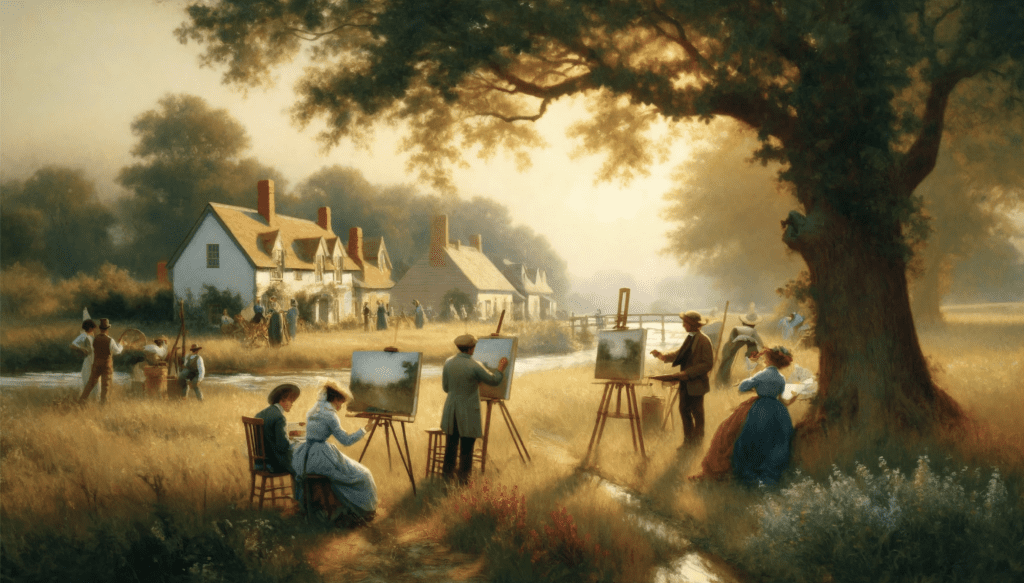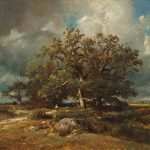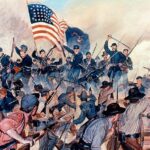
Imagine a secluded village nestled in the French countryside, where the soft light filters through the trees and a group of artists gather to share their visions. This was Barbizon in the mid-19th century, a place where painters like Jean-François Millet and Théodore Rousseau found inspiration and camaraderie. Their work would later define the Barbizon School, one of the earliest artist colonies. These colonies have played a crucial role in the evolution of art, offering a unique environment where creativity could flourish free from the constraints of urban life.
In this article, we’ll explore the rise and fall of artist colonies, tracing their origins, golden age, and eventual decline. We’ll delve into what made these communities so special, how they influenced major art movements, and why they eventually faded away. Through stories of notable colonies and the artists who lived there, we’ll paint a picture of a time when communal living and artistic collaboration were at the heart of creative endeavor. Finally, we’ll reflect on the legacy of these colonies and their influence on modern artist residencies.
By understanding the history of artist colonies, we can appreciate their impact on the art world and recognize the timeless desire for artists to seek out communities of like-minded individuals. These colonies were more than just places to live and work; they were crucibles of innovation and change, shaping the course of art history. So, let’s embark on this journey through the past, exploring the rise and fall of these fascinating enclaves of creativity.
What can we learn from these artist colonies today? How did they shape the artists who participated in them, and what lessons can modern art communities draw from their successes and failures? As we dive into the story of artist colonies, keep these questions in mind, for they are as relevant today as they were in the days of Barbizon and beyond.
I. Origins of Artist Colonies
The concept of artist colonies is as old as art itself, with early examples appearing in the Romantic era. One of the first and most famous of these was the Barbizon School, which emerged in the 1830s in France. Artists like Jean-François Millet and Théodore Rousseau were drawn to the rural village of Barbizon, seeking refuge from the rapidly industrializing cities. Here, amidst the tranquil forests of Fontainebleau, they found the perfect setting to capture the essence of nature.
What motivated these artists to form colonies? For many, it was a reaction against the urbanization and industrialization that characterized the 19th century. The cities were noisy, crowded, and full of distractions, making it difficult for artists to find the peace needed to create. In contrast, rural areas offered serenity, inspiration, and a slower pace of life. Moreover, these locations were often more affordable, allowing artists to live cheaply while dedicating themselves to their craft.
Another significant factor was the desire for a creative community. In these colonies, artists could share ideas, techniques, and critiques in an environment that fostered mutual support and collaboration. This sense of community was vital for many artists, who often felt isolated and misunderstood in the urban centers. By coming together in colonies, they created a nurturing environment that allowed for greater experimentation and innovation.
Lastly, the patrons and supporters who followed these artists to the countryside played a crucial role in sustaining the colonies. Wealthy individuals and art dealers who appreciated the artists’ work provided financial support, bought their art, and helped promote it to a broader audience. This symbiotic relationship between artists and patrons was essential for the survival and success of the colonies, ensuring that artists could focus on their creative pursuits without constant financial worry.
II. The Golden Age of Artist Colonies
The late 19th and early 20th centuries marked the golden age of artist colonies, with numerous communities flourishing across Europe and North America. One of the most iconic was Montmartre in Paris, which became a haven for artists like Pablo Picasso, Henri de Toulouse-Lautrec, and Vincent van Gogh. Montmartre was not just a place to live; it was a vibrant cultural hub where artists, writers, and musicians mingled and inspired each other. The bohemian lifestyle and the artistic synergy of Montmartre were instrumental in shaping the modern art movements that emerged during this period.
Another significant colony was the Hudson River School in the United States, centered around the Hudson River Valley in New York. This group of landscape painters, including Thomas Cole and Frederic Edwin Church, sought to capture the natural beauty of the American wilderness. Their work was characterized by a romantic, almost spiritual portrayal of nature, reflecting the broader transcendentalist movement of the time. The Hudson River School played a pivotal role in establishing an American identity in art, distinct from European traditions.
These colonies were defined by their unique characteristics and cultures. Communal living was a common feature, with artists often sharing resources such as studios, models, and materials. This collaborative environment fostered a sense of camaraderie and mutual support, which was crucial for artistic development. Additionally, the presence of patrons and art dealers provided the financial stability needed for artists to pursue their work without constant economic pressure. These patrons often became integral members of the community, further blurring the lines between creators and supporters.
The impact of these artist colonies on major art movements cannot be overstated. The Impressionists, for example, were deeply influenced by their time in colonies like Barbizon and Giverny. These rural retreats allowed artists like Claude Monet and Pierre-Auguste Renoir to experiment with new techniques and styles, leading to the development of Impressionism. Similarly, the Post-Impressionists, including Vincent van Gogh and Paul Cézanne, found inspiration in the communal and collaborative environments of these colonies, pushing the boundaries of artistic expression even further.
III. The Decline of Artist Colonies
Despite their significant impact, artist colonies began to decline in the early 20th century. One of the primary factors was the rapid industrialization and urbanization that transformed the landscape and economy. As cities grew and modernized, they became more attractive to artists seeking exposure and opportunities. The quiet, rural life of the colonies could no longer compete with the bustling energy and potential of urban centers. This shift led many artists to move back to cities, where galleries, museums, and collectors were increasingly concentrated.
The rise of new art institutions and galleries in cities also contributed to the decline of artist colonies. These urban institutions provided artists with greater visibility and access to a broader audience, making it easier to sell their work and gain recognition. The development of modern art markets and the professionalization of the art world further encouraged artists to leave the secluded colonies for the opportunities available in metropolitan areas. The communal, collaborative spirit of the colonies was gradually replaced by a more individualistic approach to art-making.
Economic factors also played a significant role in the decline of artist colonies. As the cost of living in rural areas increased and the financial support from patrons dwindled, it became increasingly difficult for artists to sustain themselves in these isolated communities. Many colonies that once thrived on the support of wealthy patrons and art dealers found themselves struggling to attract new residents and maintain their infrastructure. The economic challenges of sustaining a communal lifestyle eventually led to the dissolution of many artist colonies.
Case studies of specific colonies illustrate these broader trends. Montmartre, once a thriving artistic hub, gradually transformed into a tourist attraction, losing its appeal as a serious art community. Similarly, the Barbizon colony, which had been a refuge for landscape painters, saw a decline in residents as the surrounding area became more developed and less conducive to the artistic lifestyle. These stories reflect the broader challenges faced by artist colonies as they struggled to adapt to a rapidly changing world.
IV. Legacy and Modern Perspectives
Despite their decline, the legacy of artist colonies persists in contemporary art communities and residencies. Modern artist residencies, such as the Skowhegan School of Painting and Sculpture in Maine or the MacDowell Colony in New Hampshire, draw inspiration from historical artist colonies. These residencies offer artists the opportunity to live and work in a communal environment, fostering creativity and collaboration much like their predecessors. The spirit of the artist colony lives on in these modern institutions, providing a vital space for artistic growth and experimentation.
The lasting influence of artist colonies can also be seen in the continued appeal of communal living and collaborative projects among artists. The rise of co-living spaces and collaborative studios in cities around the world reflects a desire to recreate the sense of community and mutual support that defined the original colonies. These modern iterations often incorporate contemporary elements such as digital connectivity and interdisciplinary collaboration, bridging the gap between past and present.
Recent efforts to revive or reinterpret the concept of artist colonies have met with varying degrees of success. Some initiatives, like the creation of new artist communities in rural areas or the restoration of historical colony sites, have managed to attract artists and patrons alike. These revival efforts often emphasize sustainability, accessibility, and inclusivity, aiming to create a more diverse and resilient model of the artist colony. However, they also face challenges in balancing the demands of modern life with the traditional ideals of communal living and artistic freedom.
Success stories in the modern context highlight the enduring appeal and relevance of the artist colony model. For example, the Trestle Art Space in Brooklyn offers affordable studio space and a supportive community for emerging artists, echoing the collaborative spirit of historical colonies. Similarly, international residencies such as the Banff Centre for Arts and Creativity in Canada provide artists with the opportunity to immerse themselves in a creative environment away from the pressures of daily life. These examples demonstrate that, while the traditional artist colony may have declined, its essence continues to inspire and shape contemporary art practices.
V. Conclusion
The rise and fall of artist colonies tell a fascinating story of creativity, community, and change. From their origins in the 19th century to their golden age and eventual decline, these colonies have left an indelible mark on the art world. They provided a unique environment where artists could experiment, collaborate, and push the boundaries of artistic expression. The legacy of these colonies can still be seen today in modern artist residencies and collaborative projects, which continue to draw inspiration from the communal and supportive atmosphere of their predecessors.
Reflecting on the enduring allure of artist colonies, it’s clear that the desire for creative community and collaboration remains as strong as ever. In a world that often values individual achievement and competition, the artist colony offers a powerful reminder of the importance of mutual support and shared vision. By looking to the past, contemporary artists and art communities can find valuable lessons on the benefits of working together and fostering a sense of belonging.
What can we learn from the history of artist colonies? Perhaps the most important lesson is the value of community in the creative process. While the circumstances and challenges faced by artists today may be different, the need for connection and collaboration remains constant. By embracing the spirit of the artist colony, modern art communities can create environments that nurture creativity and innovation, ensuring that the legacy of these remarkable enclaves continues to inspire future generations.
As we ponder the future of artist communities, it’s worth considering how we can adapt the principles of the artist colony to meet the needs of contemporary artists. Whether through digital platforms, urban co-living spaces, or rural retreats, the possibilities are endless. The rise and fall of artist colonies may be a story from the past, but their influence and inspiration are very much alive today. So, let’s celebrate their legacy and look forward to the new forms of creative community that lie ahead.
Additional Elements
Throughout this article, we’ve explored the captivating journey of artist colonies, their rise, peak, and eventual decline. To enrich your understanding, I’ve included visuals of famous artist colonies, their stunning landscapes, and iconic artworks created within these communities. For further reading, check out our many related articles on the history of Impressionism, famous art movements, and modern artist residencies.




